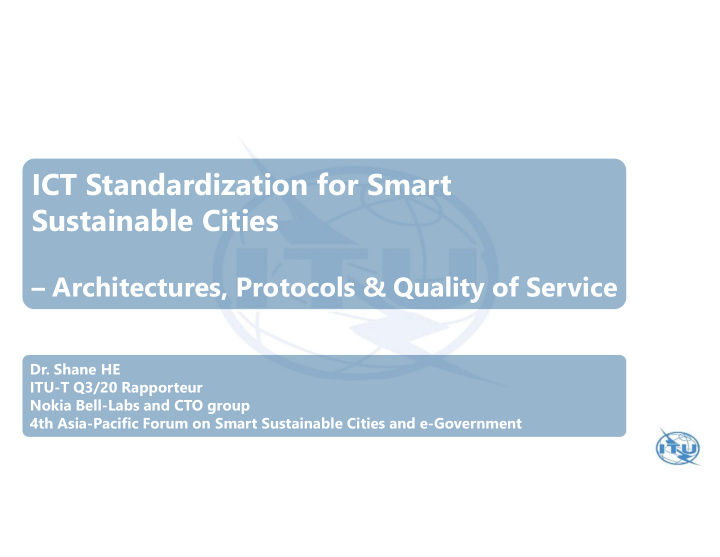



ICT Standardization for Smart Sustainable Cities – Architectures, Protocols & Quality of Service Dr. Shane HE ITU-T Q3/20 Rapporteur Nokia Bell-Labs and CTO group 4th Asia-Pacific Forum on Smart Sustainable Cities and e-Government
ITU-T SG20 Structure
Q3/20: Architectures, management, protocols and Quality of Service Scope This Question addresses IoT functional architectures, protocols, management mechanisms, and QoS (including performance) of IoT and Smart Sustainable Cities and Communities (SC&C), which needed to construct architectural frameworks for the following reasons: to control network attachment procedures (including mobility management); to control session establishment and release, to control network resources (including QoS control); to interact with services and applications and to interact with legacy networks, etc. Main Tasks Developing Recommendations, Reports, Handbooks, Guidelines, etc. as appropriate on: Conducting studies on general reference models on IoT and vertical industry needs; Developing frameworks to identify the basic architectural compositions and views on IoT; Determining the requirements that the connectivities and protocols are intended to support; Identifying performance requirements of connectivity technologies that will enable them to meet the IoT requirements; Identifying mechanisms for achieving QoS and its measurement principles required for IoT and SC&C; Identifying interfaces for interoperability between different IoT network elements; Defining interworking with legacy systems; Developing intelligence control related technologies that will provide support to IoT applications and services for various verticals and systems; Identifying mechanisms for achieving architectural interoperability for IoT and SC&C; Providing the necessary collaboration for joint activities in this field within ITU and between ITU-T and SDOs, consortia and fora. More details in: https://www.itu.int/en/ITU-T/studygroups/2017-2020/20/Pages/q3.aspx
Q3/20 main progress Approved Recommendations (2015-2016) Approved Recommendations (2017-2020)
Approved Recommendations (2017-2020) Approved TRs (2017-2020) Consent at 2018 May meeting
Q3/20 main activities Ongoing WIs Work item Subject / Title Supp-Y.IPv6-IoT IPv6 Potential for the Internet of Things and Smart Cities Y.AERS-msd Minimum set of data structure for automotive emergency response system Y.AERS-mtp Minimum set of data transfer protocol for automotive emergency response system Y.IoT-ics Requirements and functional architecture of Open IoT identity correlation service Y.IoT-rmc Reference architecture of accessing IoT resources for management and control Y.IoT-sd-arch Functional architecture of Service Discovery for Interworking between Heterogeneous IoT Platforms Y.IPv6RefModel Reference model of IPv6 subnet addressing plan for Internet of things deployment Y.IPv6-suite Reference Model of Protocol Suite for IPV6 interoperable Internet of Things Deployments Y.oneM2M.SEC.SOL oneM2M- Security Solutions Y.SSC-AISE-arc Reference architecture of artificial intelligence service exposure for smart sustainable cities Y.UIIS-IoT Unified Identity/Identifier/Locator Split (UIIS) Services and Architecture in IoT Environment
Q3/20 main activities NEW WIs Work item Subject / Title Y.dec-IoT-arch Decentralized IoT communication architecture based on Information Centric Networking and blockchain Y.cnce-IoT-arch Functional architecture of cellular-radio network capability exposure for smart hospital based on Internet of things Y.NDA-arch Functional architecture of network-based driving assistance for autonomous vehicles Y.UAV.arch Functional architecture for unmanned aerial vehicles and unmanned aerial vehicle controllers using IMT-2020 networks Y.SCCE-arch Reference architecture of spare computational capability exposure of IoT devices for smart home Y.dev-IoT-arch Architectural reference model of devices for IoT applications
ITU-T Recommendation Y.4115: IoT device capability exposure
ITU-T Recommendation Y.4418: Gateway for IoT applications Functional architecture functional entities reference points Logical flows
ITU-T Recommendation Y.4500.1: oneM2M Functional Architecture Reference Point One or more interfaces - Mca, Mcn, Mcc and Mcc’ (between 2 service providers) Common Services Entity Provides the set of "service functions" that are common to the M2M environments Application Entity Provides application logic for the end-to-end M2M solutions Network Services Entity Provides services to the CSEs besides the pure data transport Node Logical equivalent of a physical (or possibly virtualized, especially on the server side) device Application AE AE AE Layer Mca Mca Mca Mca Mca Mca Service CSE CSE CSE CSE Layer Mcn Mcn Mcc Mcc Mcn Mcn Mcc Mcc Mcn Mcn Mcc’ Mcc’ Network Underlying Underlying NSE NSE NSE NSE Network Network Layer Application Service Node Middle Node Infrastructure Node Inf. Node Multiple protocol bindings (HTTP, CoAP, MQTT, or WebSocket) over Mca, Mcc, Mcc’
Technical Report: oneM2M Industrial Domain Enablement Use case: Data Collection for Factories
Key topics in Q3/20 Services Services Smart Smart AI AI Architecture, protocol, API, Home Home management, connectivities, etc. of: IoT Identity IoT Identity Blockchain Blockchain UAV UAV Automotive Automotive
Slide 12 HS(-C1 He, Shane (NSB - CN/Beijing), 6/20/2018
Strengthening Regional & International Collaboration Regional Groups JCA-IoT and SC&C SG20RG-LATAM SG20RG-AFR Collaboration and coordination with SG20RG-ARB SG20RG-EECAT other SDOs on topics on IoT and SC&C IoT and SC&C online standards roadmap SDOs FG-DPM
oneM2M Partnership Project Over 200 member organizations in oneM2M www.oneM2M.org All document are publically available Source: oneM2M
oneM2M based smart city deployment example - Busan Source: SKT
International Collaboration Benefit: Membership of both organizations have been calling for convergence of IoT standards and alignment of work. Member The work done in both organizations is complementary. States One of the ITU-T strategic objectives is cooperation and collaboration. Converged Industry and Member States benefit from converged and aligned standards Standards Progress: 16 oneM2M Technical specifications approved as ITU-T Recommendations and 1 got AAP consent at last ITU-T Industry SG20 meeting (Y.4500 series) 6 oneM2M Technical reports approved as ITU-T technical reports Discussion is going on for next step collaboration
Thank you ITU-T, IoT and smart cities & communities http://itu.int/go/tsg20 tsbsg20@itu.int 17
Recommend
More recommend